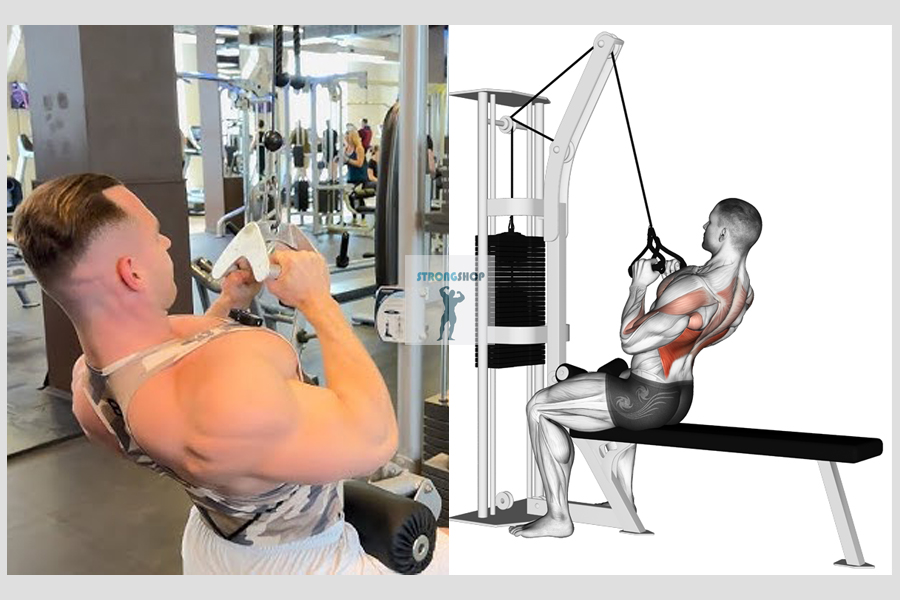The narrow parallel grip lat pulldown is an effective exercise for training the latissimus dorsi muscles.
This is a variation of the lat pulldown to the chest, performed using a specialized handle.
Contents
Advantages
Proper Usage
Technique
Common Mistakes
General Characteristics
- Exercise Type: Compound
- Equipment: Cable machine
- Difficulty Level: Easy to intermediate
- Primary Muscle Groups: Latissimus dorsi
Advantages of the Narrow Parallel Grip Lat Pulldown
- High Degree of Isolation
The narrow parallel grip focuses the load on the mid-back and latissimus dorsi, which add volume to the back.
This makes the exercise an excellent choice for those looking to isolate their back muscles effectively.
- Improved Posture and Stabilization
Since the exercise engages the back muscles and spine stabilizers, it helps maintain and improve posture, especially for those who spend long hours sitting.
Strengthening stabilizing muscles can prevent scoliosis and other spinal issues.
- Reduced Shoulder Strain
Unlike the wide-grip version, the narrow parallel grip puts less stress on the shoulder joints, making it safer. This is especially important for individuals with limited shoulder mobility or past injuries.
- Versatility for All Fitness Levels
The narrow parallel grip lat pulldown is suitable for both beginners and advanced athletes.
Beginners should start with a lighter weight, focusing on proper form and muscle engagement.
Experienced athletes can incorporate this exercise into programs for hypertrophy, strength, or definition.
Working Muscle Groups
- Primary: Latissimus dorsi, with an emphasis on the midsection.
- Secondary: Biceps.
Usage
This exercise is widely used in bodybuilding, powerlifting, and other strength training programs.
You can incorporate the narrow parallel grip lat pulldown in different ways:
- As a primary exercise for back muscles on the cable machine, performed frequently.
- As an alternative to the classic lat pulldown to the chest, performed every few workouts.
- With light weights for a "finishing" touch or heavy weights as a primary exercise.
Technique for the Narrow Parallel Grip Lat Pulldown
Proper technique is crucial for avoiding injuries and maximizing the effectiveness of this strength exercise.
Starting Position
Adjust the seat height so that the leg support rests against the top of your thighs, securing your torso.
Grip the specialized handle with a narrow parallel grip. Palms should face each other, and arms should be extended overhead.
Lean your torso back slightly, about 20 degrees.
Beginning the Movement:
Slowly pull the handle down, directing your elbows toward your torso. Avoid leaning back further; maintain a straight back.
Lower the handle to the upper chest or slightly below.
Pause briefly, feeling the tension in your lats and mid-back.
Slowly return the handle to the starting position, fully extending your arms without relaxing the muscles to maintain control.
Breathing:
Inhale as you pull the handle downward.
Exhale as you return the handle upward.
Proper breathing helps stabilize the torso and avoid unnecessary strain.
Perform the exercise slowly and with control, avoiding jerks and momentum. This ensures maximum muscle engagement and reduces the risk of injury.
Placement in Training Routine and Reps/Sets
This exercise is best performed in a back workout, following heavy compound barbell exercises.
Reps and sets can vary based on your training program. A typical range is 3-4 sets of 10-15 repetitions.
Common Mistakes and How to Avoid Them
To maximize the benefits of the exercise, avoid these common mistakes:
Excessive Leaning Back
Leaning too far back reduces the load on the back muscles and increases the risk of injury.
Wrist Bending
Keep your wrists in a neutral position. Excessive wrist bending with heavy weights increases the risk of injury.
Elbows Flaring Out
This decreases the load on the lats, reducing the effectiveness of the exercise.
Jerky Movements and Momentum
Often seen with excessive weight. Focus on controlled movements without jerks to maintain effectiveness.
Rounded Back
This is a severe technique violation that compromises the exercise and increases the risk of injury.
Conclusion
The narrow parallel grip lat pulldown is a versatile and safe exercise for training the lats and improving posture.
It allows for strength development, posture improvement, and effective back muscle engagement while minimizing shoulder joint strain compared to other grips.
Regardless of fitness level, this exercise is an excellent addition to any back training program, promoting muscle growth, strength development, and spinal support.
Links to authoritative sources
https://www.youtube.com/watch?v=IjoFCmLX7z0



